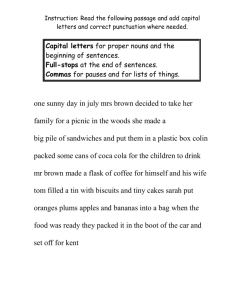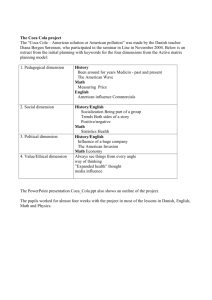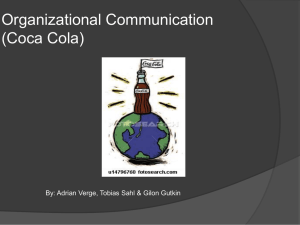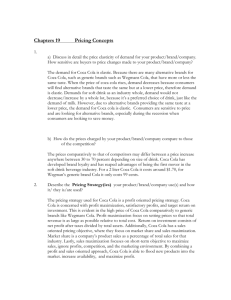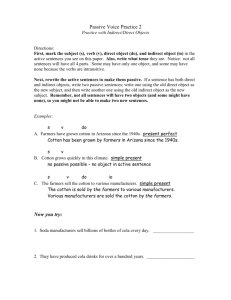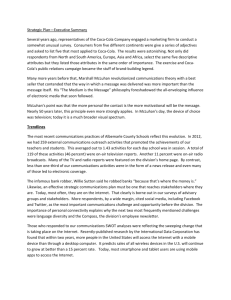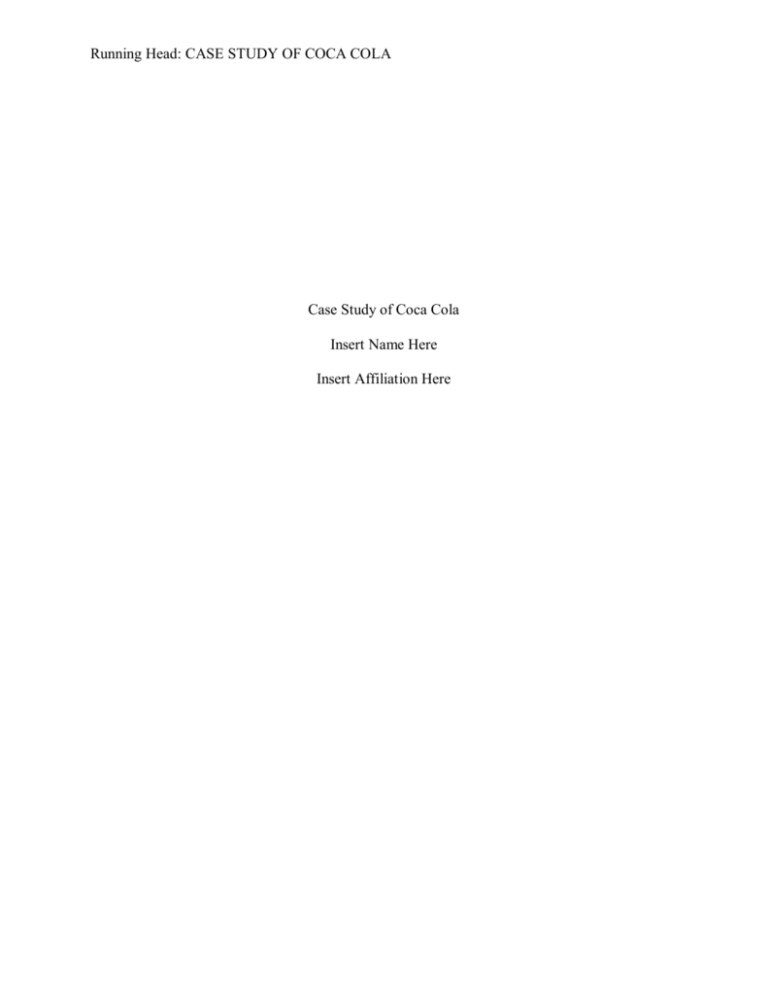
Running Head: CASE STUDY OF COCA COLA
Case Study of Coca Cola
Insert Name Here
Insert Affiliation Here
COCA COLA CASE STUDY
2
Coca Cola in a nutshell
Coca Cola was established more than 120 years ago after the invention of the original
drink in May 1986 by Dr John Smith Pemberton who was a pharmacist from Georgia, Atlanta.
The name Coca Cola and the trade mark logo are both attributed to Frank Robinson who was
partner to Dr John Smith Pemberton when they used to charge 5 cents for tasting a glass of Coke
at a local Jacob’s pharmacy. In 1988, Dr John Smith Pemberton sold his shares to an
entrepreneur who wanted to replicate the success the drink had at Jacob’s pharmacy to the
national level (Brennan et al, 2007).
After the Dr John Smith Pemberton sold his shares to the entrepreneur, the company
experienced success in the US markets which was later on followed by the company’s
establishing its presence in various foreign markets. The company first international presence
was in Canada and Mexico which was followed by the company establishing its presence in
many other foreign countries. Currently, Coca Cola has operations in more than 200 countries
and provides jobs to hundreds of thousands of people in the various countries where the
company has operations (Coca Cola 2012).
Coca Cola owns more than 3300 in more than 200 countries which consist of carbonated
drinks, light and diet beverages, juice and juice drinks, coffees, tea, and sports and energy drinks.
As far as the soft drinks markets are concerned, Coca Cola and PepsiCo are the main players
with PepsiCo been the market leader after dislodging Coca Cola from the position in 2006. The
two companies are still the market leaders in the US soft drink market and account for 76 % of
the US market (Brennan et al, 2007).
Throughout the years, Coca Cola has been developing new products that would meet
customer needs and expectations. A notable approach is the company’s strategy of introducing
COCA COLA CASE STUDY
3
drinks that are low in sugar since majority of the potential customers are concerned with their
well being and would prefer to buy drinks with no added sugar. In addition to introduction of
new products, Coca Cola has at times bought some upcoming products as well as formed
strategic partnership with other manufacturer of drinks in order to make sure that the company
remains profitable (Brennan et al, 2007).
DEEPLIST Analysis
The word DEEPLIST stands for demographics, economics, ecological/environment,
political, legal, informational, social, and technological aspects that may have effect on
operations of an organization. Conducting of a DEEPLIST analysis is important in any
organization since it helps the organization understand the environment in which it is conducting
business in. (Kerin and Peterson, 2007). According to Brennan et al, (2007) a DEEPLIST
analysis is the quite effective since it reduces the risk of forgetting an important aspect of the
environment within which a company is operating in since it includes all the major aspects
unlike in case of PEST and PESLE techniques.
Demographic
Different ages have their specific requirements. The company should target the age group
that consumes most of its brands and customize promotional and marketing strategies that suit
their behavior. The target market for Coca Cola is based on age and most of its audience is the
youth or the youngest. This is however, a wide range of targeting with ages ranging from 15-25
but it extends to 40 years and more. The growing trend among young adults is the need for
healthier drinks with high juice content and low sugar content. (Brennan et al, 2007)
In order to appeal to its target market, Coca Cola has increased its investment in
promotional activities such as family events, trade deals, bonus packs and in-store display. Coca
COCA COLA CASE STUDY
4
Cola has been spending large part of its promotional budget on sponsoring physical and
nutritional education worldwide. Other promotional activities conducted by the firm include
development of physical-activity based clubs, health camps, and funding to sports activities and
clubs in many countries.
In order to serve the different segments, Coca Cola produces different brands for specific
regions. Some of the products developed for different markets include Qoo which is a light
carbonated juice drink which is targeted for Taiwan and Asian countries, Burn energy drink
which is aimed at the Spanish and European markets and Samuria in Afghanistan. (Coca Cola,
2012, Brennan et al, 2007)
Economic
Over the years, Coca Cola has been facing increased advertising controls, price
restrictions, lack of infrastructure, foreign exchange controls and increase competition from
companies such as Cadbury Schweppes and Pepsi (Brennan et al, 2007). These economical
factors have in turn affected the market share of Coca Cola in various countries.
Environmental
As discussed by Brennan et al, (2007), the impacts that Coca Cola operations have on
environment can be disastrous to the operation of the company. In India, Coca Cola together
with its fierce rival Pepsi received negative publicity after a report released by Indian based CSE
showed that the two companies pumped a lot of water from villages making public wells to dry
up which resulted to people lacking access to enough water that is necessary to meet their basic
needs(Brennan et al, 2007). In response to these accusations, Coca Cola was forced to minimize
on its water usage by 25% and in addition build dams which would be used to harvest rainwater.
COCA COLA CASE STUDY
5
Political
Being an international company Coca Cola faces different political landscapes in its areas
of operation. The company is faced with political instability in many countries where it has
operations. Environment protection laws imposed by governments in different countries have
made the firm to undergo some hurdles in their operations. In 2006, the company was sued by
State of California for using lead in on its labels, which it was forced to change. The company
was also charged for practicing monopoly in Mexico after forcing some restaurants and stores to
agree to some exclusive contracts (Brennan et al, 2007)..
Legal
Legal aspect includes the constraints or limits on business operations. In its bid to gain
market monopoly in Mexico, the company went against the Federal anti-competition laws
prohibiting retailers to agree to exclusive rights. Coca Cola faced the same regulation when it
tried to acquire Cadbury Schweppes in 1999. The company also faced EU regulations in 2005
after the company tried to force retailers to include its less popular brands in addition to Coke
(Brennan et al, 2007).
Informational
Coca Cola has a secret concentrate recipe that has enabled it to have control over its
distribution channel. This has enabled the company maintain strong control of the prices that
bottlers pay for the concentrate, their obligation to distribute and market Coca Cola products and
regularly up grade their plants. In addition, Coca Cola also maintains the right to distribute its
products directly to retailers and restaurants selling from fountain pumps. The company’s
franchisees are only allowed to distribute soft drinks products of producers who are not in direct
completion to Coca Cola. The company has also invested significantly in developing bottlers and
COCA COLA CASE STUDY
6
franchisees. Coca Cola has recently developed a multi-billion data warehousing and decision
support system in order to ensure efficient and effective communication with its affiliates around
the globe (Brennan et al, 2007). Since the company operates in different countries in different
environments, Coca Cola has been forced to restructure some of the practices so that they are in
line with regulations in different countries.
Social
There has been a rapid growth in the segment for healthier drinks with higher juice
content and low sugar content. The target markets for these drinks are adults above the age of 25
who are increasingly becoming aware of health issues. The company introduced Coca Cola C2 in
Japan, a product featuring low carbohydrates, sugar, and calories. The company has produced
more brands with low calories and sugar such as Minute Made Light and Coke Zero (Brennan et
al, 2007). Some brands are lifestyle oriented targeting people with busy lifestyles, sports people,
and mobile generation. Coca Cola has brands targeting people according their lifestyles and this
saw the introduction of energy drinks and drinks on plastic packages.
Technology
Changes in technology have created opportunities for creation of new products and
product improvements. Another important factor is the emergence of new marketing
technologies such as e-commerce and social networking. The company has effective marketing,
advertising, and promotional programs. The new technology has made advertisement to make
some products more attractive. The introduction of plastic bottles and cans have significantly
increased the sales of Coca Cola since they are easier to carry and dispose. Technological
advancement has enabled the firm to develop new environmentally friendly bottles which are
light weight (Kerin and Peterson, 2007).
COCA COLA CASE STUDY
7
Coca-Cola SWOT Analysis
A SWOT analysis as discussed by Kotler (2011) is usually applied when one wants to
examine both the internal and external environment within which an organization operates in.
Conducting a SWOT analysis involves investigating the strengths, weakness, opportunities and
threats of an organization. In reference to Coca Cola, conducting a SWOT analysis will help
find out the company’s strengths that can be used to help Coca Cola to be positioned as market
leader in the soft drinks market while at the same time been well prepared to respond to any
threats in the market. In addition, weaknesses established can be addressed where as any
opportunities identified can be maximized on.
SWOT Analysis of Coca Cola
Strengths
Weaknesses
Very strong brand that is well
Negative publicity
recognized throughout the world
Declining cash from operating
Large distribution channel
Strong global footprint in emerging
activities
markets
Popular brand
Willingness to produce brand
Opportunities
Low success levels in North
American markets
Negative publicity
Threats
Demographic changes in the West
Increasing competition
Growing market for bottled water
Dependence on bottling partners
Declining growth of carbonated
drinks
COCA COLA CASE STUDY
8
Strengths
Coca Cola is the market leader in the soft drink markets and has a market share of about
53% of the market which is enhanced by the company’s various brands (Forbes, 2011).
Operations of the company are supported by well established distribution system that makes sure
that the products are available in all countries that the company has operations in. The company
is the only manufacturer of the secrete concentrates, carbonated water and recipes, which are
sold to retailers and other distributors (bottling partners). These authorized bottling partners these
concentrates and recipes to produce finished beverage products. In North America, the company
owns 65 beverage production plants, 10 major beverage concentrate and syrup manufacturing
facilities, four bottled water facilities and 10 principle beverage concentrates for food service.
The company has strong control over its bottling partners in terms of prices they pay for the
concentrate, distribution and marketing of Coca Cola products, and obligation to up grade plants
regularly. In contrast to other concentrate producers, the company owns the right to distribute
directly to retailers and restaurants that merchandise from fountain pumps. The company has also
invested significantly on data-warehousing and decision-support system (Brennan et al, 2007).
The company has a strong global footprint highlighting emerging markets. Coca Cola has
a strong presence in established markets of North America and Europe and is also expanding into
emerging markets of Asia and Africa which present huge market potential as compared to
developed regions. Global presence in several geographic regions ensures diversified stream of
revenue and reduces business risk (Brennan et al, 2007).
Coca Cola has a popular brand and this has enabled it to secure more shelf space in
grocery stores as compared to other competitors. The company has exclusive deals with the
world’s largest food outlets, McDonalds and Burger King. Other key distribution channels
COCA COLA CASE STUDY
9
include convenience stores, vendor machines, and fountain outlets (Kerin and Peterson, 2007).
The company also has a broad product range featuring more than 2,400 products and 400 brand
names. In addition, the company is able to produce specific brands for specific markets which
make it meet its customers needs (Brennan et al, 2007).
Weaknesses
Increased competition from other soft drinks and food producers has made the company’s
strong brand to dwindle. The change in consumer taste in the mid 1990s from sugar-based soft
drinks to energy drinks, bottled waters, juice based sodas, and healthier alternatives has greatly
affected the demand for the company’s popular brands (Brennan et al, 2007)..
Most of the brands produced by Coca Cola are not good for health. There is growing
concern over sugar content in the company’s soft drinks which scientists have argued that
contribute to poor diet and growing problem of obesity especially among children. In addition,
the target market for Coca Cola is mainly younger people. It overlooks the elderly even though it
presents potential for future for this market segment that can profitable to the company (Brennan
et al, 2007).
Opportunities
The change in demographics in the West connotes more opportunities for the company to
produce more products that appeal the ageing and increasingly health conscious market (Brennan
et al, 2007).Bottled water is one of the fastest growing market segments in the world’s beverages
and food market due to increasing health concerns among consumers. The market for bottled
water generated revenues of more than $15.6 billion in the US in 2006. The market consumption
volume is expected to increase significantly in the next few years. The company’s Dasani brand
is among the best-selling bottled waters in the market. Coca Cola should leverage its strong
COCA COLA CASE STUDY
10
position in the bottled water segment in order to take advantage of growing demand for flavored
water (CNN, 2010).
There is growing in the market for ready to drink non-alcoholic drinks. The non-alcoholic
market is expected to continue growing retail sales for the next years to come. This market will
add more than 50,000 million unit cases and expand retail sales by more than $ 5000 billion.
This projected growth is being fueled by increase in income of middle-class consumers who will
increase their purchasing power. The company should benefit from expanding its product
portfolio to meet the demands of the non-alcoholic ready to drink market (Coca Cola, 2012).
Since 1897, the company has been expanding its operation to the international market
through alliances and acquisitions. The company now has 28 plants in China and many more
plants in other parts of the world (Brennan et al, 2007). In 1991, Coca Cola and Nestle formed a
joint market Nestlé’s Nestea and Nescafe by leveraging the company’s distribution network.
Another joint venture was between Coca Cola and BPW (Beverage Partners Worldwide)
focusing on coffee and tea brand drinks, including Coca Cola’s Chinese tea brands, Yang
Guange and Tian Yu Di. Similar brands have also been introduced in Europe as part of a joint
venture with Nestle. Stronger international operations increase the capacity of the company to
penetrate the international markets and also give it an opportunity to diversify its revenues.
(Brennan et al, 2007).
Threats
There is intense competition in the non-alcoholic beverages segment of the commercial
beverages market. There is competition faced by the company from both regional as well as
international players. In addition, the company faces stiff completion from various non-alcoholic
drinks including fruit drinks, nectars and juices. The major competitor to the company in its
COCA COLA CASE STUDY
11
areas of operation is PepsiCo. Other noteworthy competitors include Cadbury Schweppes,
Nestle, and Kraft Foods. Competitive factors that affect the business of the company include
advertising, pricing, product innovation, sales promotion, and trademark and brand development
and protection. Increased competition could have significant impact on the market share and
revenue growth of Coca Cola (Brennan et al, 2007).
Coca-Cola Environmental analysis
Factors
Clarity
Impact
Probability
Urgency
Demographics
70 %
66 %
80 %
15 %
Economics
50 %
80 %
65 %
16 %
Environment
80 %
95 %
90 %
85 %
Political
60 %
70 %
75 %
80 %
Legal
50 %
60 %
85 %
65 %
Informational
60 %
60 %
75 %
60 %
Social
75 %
70 %
85 %
65 %
Technological
68 %
75 %
80 %
70 %
Opportunities
78 %
80 %
70 %
60 %
Weakness
50 %
75 %
80 %
80 %
Threats
80 %
90 %
80 %
100 %
In the table above, Coca Cola environmental factor analysis have been outlined to
determine the appropriate response that the organization should adopt. Clarity illustrates the
nature of the information available on the factor and how reliable is the information. Impact on
the other hand identifies the effect that the factor could have on the organization if it occurred
where as probability shows the likely hood of the event occurring. The final section which is
COCA COLA CASE STUDY
12
urgency shows how soon a response to the identified factor should be taken. Though the
percentages indicated were initially developed from a scale of 1 to 5 with 1 been unlikely and 5
been very unlikely, the points were later converted to percentage to make it easy to comprehend
for anyone reading this report.
Ansoff growth Matrix
The Ansoff growth matrix as discussed by Lester (2009) is a commonly known tool that
is used in analyzing various growth opportunities. Lester (2009) contends that the tool is quite
effective in driving clear strategic thinking around growth. The concept of the tool as discussed
by Kumar (2010) is based on the concept that in order for a company to achieve growth, the
company has to decide how and where its needs to compete; is it in the current markets or is it
new markets and is it going to launch new products or is the company just going to market the
already existing products.
The Ansoff growth matrix as discussed by Lester (2009) has four boxes that usually
consist of four different strategies that can be adopted by a company. The four strategies usually
involve expanding into new markets, diversifying into new product for different market, aiming
to increase market share and developing new products to meet the needs of existing market
better.
A closed look at Coca Cola strategies shows that the company implements two strategies.
The first strategy involves Coca Cola identifying the market that it wants to serve and then
deciding the products that the company will offer to the chosen market. As far the markets are
concerned, Coca Cola is usually faced with the option of either remaining in the current market
or expanding into new markets. In order for Coca Cola to remain competitive in the markets that
the company has already established its presence, the company usually diversifies its product
COCA COLA CASE STUDY
13
offering to include various products. Infact, Coca Cola can be argued to have implemented the
diversification strategy way back in the 1960s when it acquired Minute Maid Corporation, a
producer of Hi-C fruit drinks. Coca Cola and Nestle agreed to joint marketing for Nestlé’s
Nescafe and Nestea brands by leveraging the company’s wide global distribution network. The
company has franchised the production rights to its bottling partners making it greatly reduce
overheads while at the same time increasing its global market share (Brennan et al, 2007).
Coca Cola has a strong brand with unique attributes relative to similar alternatives in the
market. Given its popular brand, the company has been able to get more shelf space in
supermarkets, which are the main distribution point for Coke’s products. The company invests
heavily on advertisement and marketing to maintain the brand identity and increase barriers for
competitors willing to enter this market (Brennan et al, 2007).
Coca Cola uses a mix of strategies, which include both differentiation and cost focus.
Even though Coke brand is the company’s largest seller worldwide, Coca Cola is still willing to
produce local brands. The company has products in its portfolio catering to specific regions and
countries. In addition, the company introduces new product into the market each year as a means
of staying ahead of the market. The company has also launched bottled waters, flavored waters,
energy drinks, indulgent chocolate-flavored beverages, orange juices, and ready-to-drink canned
coffee. The company targets all market segments and provides a range of brands suiting the
needs of each segment (Brennan et al, 2007).
Growth and profitability is the main objective of all organizations. There main aim is to
grow and expand in different markets increasing variety in their products (Brennan et al, 2007).
Coca Cola can identify its expansion strategy through the ANSOFF approach. Coca Cola is
doing market penetration through selling its product to business buyer, which includes
COCA COLA CASE STUDY
14
multinational organizations such as McDonalds, Burger King and many more in addition to its
bottling partners. The company also has buyers who are selling the Coca Cola as the only
beverage in their restaurants (Brennan et al, 2007).
The market development of Coca Cola includes exploring the international market for
products that they are already selling. The company first entered the international markets in
1897 when it made Coke available in Mexican and Canadian shops with soda fountains. This
was followed by setting up plants in China and many other locations around the world. The
company has formed alliances and joint ventures with global companies in the bid to increase its
global market share. The company has been introducing different flavors in order to change the
beverage industry (Brennan et al, 2007).
There are risks involved in when conducting product development such a loss of
customers or demand from some segments for their product. Coca Cola Company can do product
development by introducing new flavors in specific regions, which are not sold by Coke in other
regions in the world. The company has put more effort in that and introduced product portfolio
catering for specific regions and countries. The company introduced Qoo in Taiwan and other
Asian countries, Burn Energy drink in Spain and Eastern Europe, Samuria in Afghanistan among
others (Brennan et al, 2007).
The company needs to adopt diversification strategy. There are many demographic
changes presenting opportunities for growth even though there are associated risks. The
company only deal with beverages and bottled water but it can manufacture and distribute its
own snacks since the company has that is known all worldwide. It can make more cash by
making and selling items that can be taken with the beverages that Coca Cola sells. (Brennan et
al, 2007).
COCA COLA CASE STUDY
15
The other growth options that Coca Cola can consider are not necessarily related to
diversification. In both cases, the company sells new products to new markets. The company can
diversify into pure fresh juice products. Unrelated diversification for example is a case the
company diversifies into markets and products that are new like manufacturing sportswear
should also result to higher profits for the company. It is however to highlight diversification into
manufacturing of sportswear would present great risks meaning that Coca Cola should only
consider this strategy if the prospect for growth in the beverages sector is very low or the
demand for the products ceases.
Update of Coca Cola
A look at Coca Cola’s strategy and its current market share as far as the global soft drinks
market is concerned shows that the company in very good position. Coca Cola has managed to
successfully expand to over 200 countries since its inception which has resulted to 76% of the
company’s revenues coming from foreign markets. (Brennan et al, 2007). Figures obtained from
Forbes (2011) shows that the company has managed to once again dominate the soft drinks
global market after dislodging its US based giant rival PepsiCo in 2010. As of 2010, Coca Cola
has a market share of 53% which is commendable considering that there are other established
manufacturers of soft drinks in the world. The fact that the company has also managed to
introduce various new products while at the same time managing stick with the core products is
also commendable since new customers who are mainly health conscious have been attracted.
Though very hard to establish the actual financial targets of the company, reports from BBC
(2011) shows that the company is moving from strength to strength as it reported that it had
made profits of $2.2 Billion in the third quarter which was a 12% increase into the previous
year’s revenues. The fact that Coca Cola has recently acquired more bottling operations in the
COCA COLA CASE STUDY
16
North American markets in addition to the pledge that it will invest $4 Billion in China can serve
as an indicator that the company is going to report higher revenue figures in the coming years.
Since the company has been accused of having negative impacts to the environment, as
well as selling products that are harmful to the consumers, Coca Cola should invest more on
research and development to establish whether it is possible for the organization to produce
carbonated drinks that would have no side effects to the consumers. In addition, the company
needs to be involved with corporate social responsibilities that aim at betterment of the welfare
of the community. Even though Coca Cola has already been involved in various corporate social
responsibilities initiatives (Coca Cola, 2012) there is a need for a higher degree of involvement
in such initiatives which will play a great role in helping built the image of the company in areas
like India where Coca Cola has been heavily criticized for polluting the environment (India
Resource Center, 2011)
In conclusion, Coca Cola strategies are very well developed and executed a fact that can
be explained by the performance of the company. The company should now invest more of
products that are deemed to be healthy since the segment is growing on an alarming rate. It is
however to highlight that from the analysis of Coca Cola’s environment and the strategies that
the company has put into place, the company will continue to be a major player in the soft drinks
sector.
COCA COLA CASE STUDY
17
References
BBC (2012). Coca Cola reports $ 2.2bn profit and 45% revenue jump.
Retrieved March 29, 2012 from www.bbc.co.uk/news/business-15348200
Brennan, R. Tunisini A., Harrison D., Baraldi E. (2007) Contemporary Strategic Marketing. (2nd
Ed). New York: Palgrave Macmillan
Coca Cola (2012). Company’s official website. Retrieved March 29, 2012 from www.cocacola.com
CNN (2010). Bottled water faces backlash. Retrieved March 29, 2012 From
http//:articles.cnn.com/2010-0422/living/blacklash.bottled.water_1_bottled-water-international-bottled-waterassociation-corporate-accountability-international?s=PM:LIVING
Forbes (2012). Coca-Cola profit beats as brand grabs global market share. Retrieved March 29,
2012 From
www.forbes.com/sites/heatherstruck/2011/07/19/coca-cola-profit-beats-as-brand-grabsglobal-marketsgare/
India Resource Centre, (2011). Water levels continue dropping sharply: Coca Cola extracts
groundwater even as farmers and communities left without water. Retrieved March 29,
2012 from www.indiaresource.org/news/2011/1008.html
Kerin, R. Peterson, R.P. (2007). Strategic marketing problems: cases and comments. California:
Pearson/Prentice Hall.
Kotler P., Keller K. (2011). Marketing Management, (14th Ed.) London: Prentice Hall.
Kumar D. (2010). Enterprise growth strategy: Vision planning and execution. England, Surrey:
Gower Publishing Ltd.
COCA COLA CASE STUDY
Lester A. (2009). Growth Management: Two hats are better than one. Hampshire: Palgrave
Macmillan.
18


